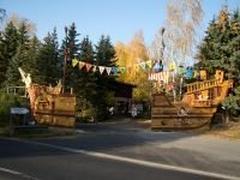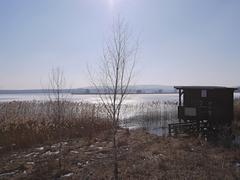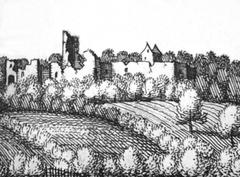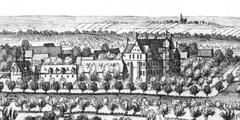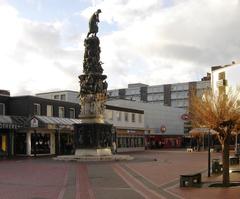Guide to Visiting Schloss Henneckenrode, Heere, Germany
Date: 01/08/2024
Introduction
Schloss Henneckenrode, nestled in the charming village of Heere in Lower Saxony, Germany, is a historical gem with roots tracing back to the 13th century. Initially a knight’s estate under the Counts of Wohldenberg, it evolved into a significant cultural landmark over the centuries. The castle’s architectural journey began with Heinrich von Saldern’s construction in the Weser Renaissance style, notable for its ornate facades and decorative gables (Second Wiki). The castle saw periods of transformation, including reconstruction after a devastating fire in 1588 and its transition to the Counts of Bocholtz in 1684. Over the years, Schloss Henneckenrode served various roles, from a noble residence to an orphanage, and more recently as a children’s and youth home until 2017 (Wikipedia). Today, it stands as a testament to resilience and architectural splendor, attracting visitors for its rich history, beautiful gardens, and cultural significance. This guide aims to provide comprehensive information for anyone planning to explore this magnificent castle, including its history, visiting hours, ticket details, and tips for an enriching visit.
Table of Contents
- Introduction
- Early Beginnings and Ownership
- Construction and Architectural Style
- The Fire of 1588
- Transition to the Counts of Bocholtz
- The Blum’s Orphanage Foundation
- Modern Era and Restoration Efforts
- Recent Developments and Current Status
- Architectural and Cultural Significance
- The Castle Church
- Visitor Information
- FAQ
- Conclusion
Early Beginnings and Ownership
Schloss Henneckenrode dates back to the early 13th century when it was a knight’s estate belonging to the Counts of Wohldenberg. By the end of the 13th century, it transitioned to the Bishop of Hildesheim, who granted it as a fief to the von Heere family. This arrangement continued until the von Heere lineage became extinct in 1567, after which Burchhard von Saldern became the new leaseholder (Wikipedia).
Construction and Architectural Style
Heinrich von Saldern, son of Burchhard von Saldern, constructed Schloss Henneckenrode between 1579 and 1580 in the Weser Renaissance style. This architectural style is characterized by its ornate facades, decorative gables, elaborate doorways, and the use of sandstone (Second Wiki).
The Fire of 1588
In 1588, a significant fire broke out at Schloss Henneckenrode, leading to a substantial reconstruction effort. The rebuilding process likely involved restoring the castle’s original Renaissance features and possibly incorporating new elements to enhance its resilience and aesthetic appeal (Wikipedia).
Transition to the Counts of Bocholtz
In 1684, the castle came into the possession of the Counts of Bocholtz. This period marked a significant chapter in the castle’s history, as the Bocholtz family maintained ownership until 1820. Due to financial difficulties, the family had to cede the property to Friedrich Blum, who envisioned transforming it into an orphanage (Second Wiki).
The Blum’s Orphanage Foundation
Following Friedrich Blum’s death, the castle was renovated to accommodate its new function as an orphanage. The Blum’s Orphanage Foundation officially opened in 1838, providing shelter and care for orphans. This philanthropic endeavor continued until 1856 when the Sisters of Mercy took over the administration (Wikipedia).
Modern Era and Restoration Efforts
In the late 20th and early 21st centuries, Schloss Henneckenrode underwent several restoration projects to preserve its historical and architectural significance. Between 1999 and 2000, a garden area adjacent to the castle was meticulously reconstructed. Further restoration efforts in 2012 and 2013 focused on the castle’s facades and the revitalization of a silted pond, with costs amounting to approximately 800,000 euros (Wikipedia).
Recent Developments and Current Status
Until 2017, the Caritas Association of the Diocese of Hildesheim operated a children’s and youth home within the castle. However, due to the need for extensive renovations, estimated at over 2 million euros, the decision was made to relocate the facilities. Despite community efforts to preserve the castle’s role as a youth home, it was put up for sale in 2019, with the sale process postponed by the Diocese of Hildesheim in 2020 (Wikipedia).
Architectural and Cultural Significance
Schloss Henneckenrode is a quintessential example of Weser Renaissance architecture, featuring a west-facing front with a central risalit and robust, towering pillars. The castle forms a four-wing complex with a large inner courtyard, complemented by two pavilions, a former castle church, and a landscaped park with a 2.6-hectare pond fed by the Nette River. The entire ensemble has been under monument protection since 1988 (Wikipedia).
The Castle Church
Within the castle grounds lies St. Joseph’s Church, originally built as a castle church by Burchard von Saldern in 1597. Today, it serves as part of the Catholic parish of St. Hubertus, Wohldenberg. The church’s historical and architectural value adds another layer of significance to the Schloss Henneckenrode complex (Second Wiki).
Visitor Information
Visiting Hours and Tickets
Before planning your visit, it is essential to check the current status of the property, as it has been listed for sale and may have restricted access. Typically, the castle grounds can be explored from 9 AM to 6 PM. It is advisable to contact the local tourism office for the most up-to-date information on visiting hours and ticket prices.
Accessibility
The castle is located near major highways, including the A7, A39, B6, and L439, making it easily accessible by car. Parking facilities are available on-site.
Travel Tips
- Nearby Attractions: The village of Henneckenrode and the broader Hildesheim district offer ample opportunities for cultural and historical exploration.
- Guided Tours: Check if guided tours are available to enrich your visit with detailed historical insights.
- Photographic Spots: The landscaped park and the restored garden and pond provide excellent spots for photography.
FAQ
What are the visiting hours for Schloss Henneckenrode? Typically, the castle grounds can be explored from 9 AM to 6 PM. Check with the local tourism office for the most up-to-date information.
Are there any ticket prices for visiting Schloss Henneckenrode? It is advisable to contact the local tourism office for information on ticket prices.
Is Schloss Henneckenrode accessible by car? Yes, the castle is located near major highways, and parking facilities are available on-site.
Can I take guided tours of Schloss Henneckenrode? Check with the local tourism office to see if guided tours are available during your visit.
What nearby attractions can I visit? The village of Henneckenrode and the broader Hildesheim district offer many cultural and historical sites worth exploring.
Conclusion
Schloss Henneckenrode’s history is a testament to its resilience and adaptability, evolving from a knight’s estate to a Renaissance castle, an orphanage, and a youth home. Its architectural splendor and cultural significance continue to attract visitors, ensuring that its legacy endures for future generations. For the latest updates and to plan your visit, download the Audiala mobile app, check out related posts, or follow us on social media.
References
- Wikipedia, 2023, Various Contributors source url
- Second Wiki, 2023, Various Contributors source url

